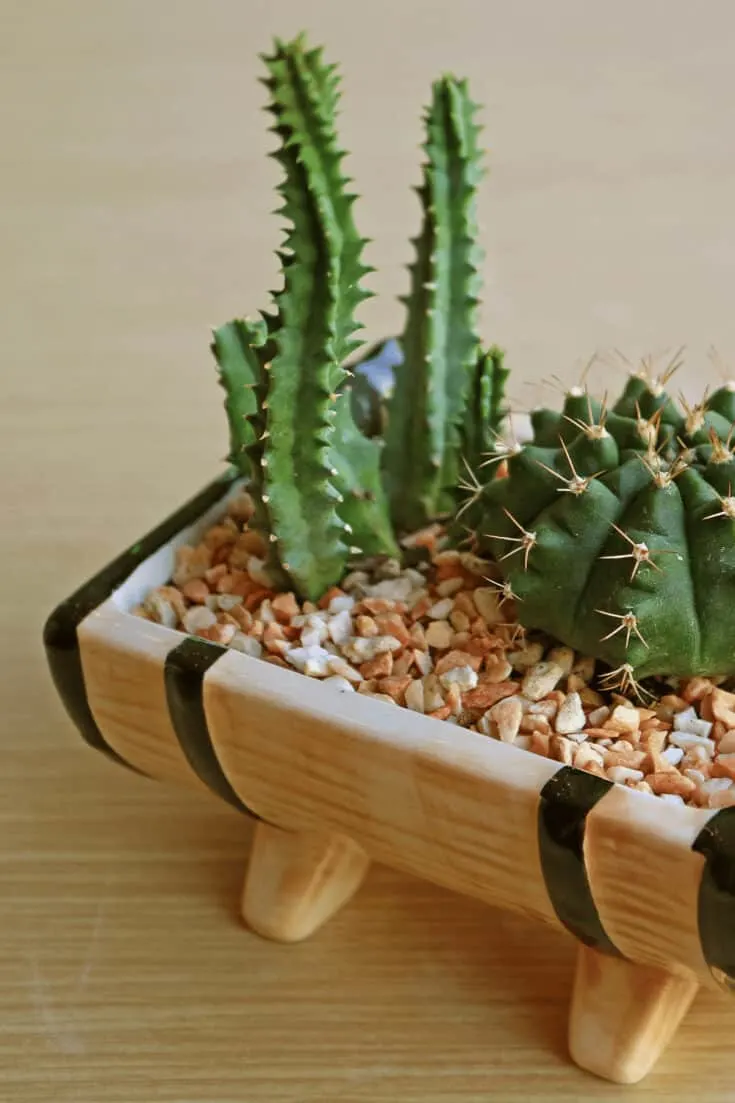Fairy castle cactus is scientifically known as Cereus or Acanthocereues tetragonus, to be specific.
It is a special type of cactus grown in North America.
It also originates in areas such as Mexico, Brazil, and Central America.
The name derives from the way the vertical stems grow at various heights with a long pointy stem, resembling the turrets of a castle.
The tiny hair spines form a white skeleton outline. From the look of it, it has other common names and is also called – Triangle Cactus, Sword Pear, or Barbed Wire Cactus.
Fairy Castle Cactus Care
To care for a Fairy Castle Cactus use a well-draining soil mix using perlite, vermiculite, cocopeat, sand and gravel, and cow manure. Provide partial or full direct sunlight and watering every 2-3 weeks. A temperature between 64-79°F is ideal (18-26°C). Fertilize monthly in spring and summer using a liquid all-purpose fertilizer.

Fairy Castle Cactus Care
Table of Contents
Fairy Castle Cactus Guide
They are great to add fresh air fresh if you place them indoors, as they eliminate toxins from the environment.
If you wish to make your garden or home look uniquely exotic, then getting a fairy castle plant will not disappoint you.
Fairy castle cacti depend entirely on proper sunlight and well-drained soils. This cactus has slow growth and can reach up to 6 (182cm) tall. The stem grows with 5 pointy sides ending with tiny spines on each plane.
The colors vary from dark green to light green and can turn brown once it fully matures.
If you provide proper care, you can be lucky to observe large flowers of white and yellow shades. This can occur once the plant reaches a mature age of more than 10 years.
Fairy castle cactus is easy to care for and is most commonly used as an indoor plant.
You can easily find them in nurseries or local stores.
Growing them outdoors is possible in USDA hardiness zones 10a and 11b.
Soil
Fairy Castle Cactus requires well-drain soil to avoid any water evaporation that can be due to direct sun.
Fairy Cactus soil mix:
- 30% perlite
- 15% vermiculite
- 15% cocopeat
- 30% sand and gravel
- 10% cow manure
This creates a medium that can hold enough nutrients and air for the roots. For the potting mix, you can use loose, porous, or fast-draining soil.
They prefer neutral to slightly acidic soil and pH values between 6.1 – 6.5.
Light
Place a Fairy Castle Cactus in an area with partial or full sunlight.
Keep it away from drafts or in air conditioning spaces.
If you place it indoors, place it 2-5 feet away from windows or doors where it can receive full sunlight.
Windows can amplify the sun’s intensity that can damage the stem of the cactus. It is always best to keep the cactus at a distance from the windows.
In outdoor conditions, place it on open ground, do not place it under trees that provide shade as this can lower the sunlight availability.
Remember, that cactus love sunlight and grows best under the sun.
Some cacti however that do not have spines grow best in low-light areas.

A Fairy Castle Cactus grows best in full sun
Watering
The Fairy Castle Cactus requires watering generally once every 2-3weeks.
Ensure that the excess water reaches the bottom of the soil while adding 2-3 drainage holes at the bottom of the pot.
Do not over-water the plant as it can lower the plant productivity and attract fungal infections.
Temperature
A Fairy Castle Cactus tolerates temperatures between 30-90°F (-1.1-32°C). However, a temperature between 64-79°F is ideal (18-26°C)
Since they thrive best in full sunlight, they grow best in summer or warm climate conditions.
During the wintertime, you will need to water a little less and keep it indoors. As too much exposure to cold weather can kill the plant.
However, these cacti have proven to withstand temperatures ranging from 30° F – 90° F (-1.1 °C – 32°C).

Fairy Castle Cactus can tolerate temperatures between 30-90°F (-1.1-32°C)
Flowering
Flowers are rarely observed, and it depends if your species has the trait of giving flowers.
If it does, the flowers can grow up to 5.5-8” (14-20 m) in diameter with a tube of 5.5-6” (8-15 cm).
Flower color ranges from greenish-white, creamy white, reddish-orange to yellow.
The flowers bloom at odd timing from midnight to dawn, while some can bloom in the daytime.
Pest and Diseases
Cactus has strong resistance towards any serious diseases. However, inadequate care such as over-watering can cause bacterial or fungal diseases.
The most commonly observed insects are whiteflies and mealy bugs.
Fertilizer
Fertilize a Fairy Castle Cactus monthly using a liquid all-purpose fertilizer in spring and summer.
This cactus does not need a specific fertilizer, it grows well with an all-purpose fertilizer.
Fairy castle cacti however require frequent fertilizer application.
I suggest a monthly application in Spring and Summer.
Reduce or stop fertilization in Autumn and winter time as this is the season where the least cactus growth takes place.
However, in the winter season, it does not require any fertilizers due to its dormant phase.
During this phase, the plant does not grow effectively and waits for the ideal temperature (summer/warm weather) to resume its growth.
Propagation
Fairy castle has the ability to propagate easily by cutting its top stem. Cut the stem equal to the length of your hand.
After cutting, replant the stem into damp and well-drained soil. The moist soil helps the fresh cutout stem to harden and initiate root growth.
The roots will completely develop after 2 to 3 months.
During the first month of propagation, the Fairy castle cactus can be sensitive to direct sunlight for longer periods.
Do not keep it under sunlight for too long or over-water it.
Since it is trying to grow, water it once a week while keeping it under shade or in low light areas.

Fairy Castle Cactus can be propagated by top stem cuttings
Growth
The growth rate of almost all cacti is slow, it can be quick at the beginning but gradually slows down with time.
This cactus is a slower grower that can grow up to 6 feet (182cm).
Potting
The cactus needs adequate space for its roots, hence repotting should be applied once every year.
The new pots need to be 1-2 inches larger with a potting mix.
The spins can hurt you, remember to always use leather gloves or tongs to repot or move the cactus.
Common problems with the Fairy Castle Cactus
- Do not panic when the growth rate decreases because, in the beginning, the fairy castle cactus grows faster than later.
- Corking is a sickness when a natural process of aging starts, so do not get worried when the base of the stems turn brown and woody. It is very necessary for the stability of the plant. Corking is when the base stems of fairy castle cactus turn brown or form a woody texture. This happens when the plant reaches old age and it normally a natural phase of a cactus life.
- However, this can also occur in the beginning. If you notice it in the early development growth, then the cactus might suffer from disease or fungal infection. Check for any insects or bugs that are eating up your plant and apply appropriate treatments.
- If you get any fairy castle cactus in a small pot, you will probably need to transfer it to a bigger pot in the next year. This is necessary for the roots to grow.
- If you observe brown spots distributed in the cactus, this means a pest is infecting the cactus. It can also be a sign of fungal infection. Use neem oil on the cactus and ensure you do not over-water your cactus.
Tips to Keep the Fairy Castle Cactus problem-free
To keep fairy castle cactus problem-free adequate care of it requirements in terms of watering, soil texture, repotting, and light is necessary.
When you know the weather is about to hit the harsh months of summer and winter, then keep the plants prepared.
In extreme summer, keep the cactus from direct sunlight and place it in a partial shade area. In winters, keep the plant indoors and away from windows while positioning it towards any source of light.
Cactus are characterized to grow in the desert and require little water, hence over-watering your Fairy castle cactus can kill the plant’s growth.
Check for any possible signs of pest every 2 weeks. If you observe a pest, use any pesticide organic spray on the surface of the affected area.
Fairy castle cactus is mildly toxic to pets, adjust it to places where pets cannot easily come in contact.
When keeping the plants in a secure place, ensure there are no AC or heating vents that can affect the plant. Do a quick check by placing your hands and feeling any heat change in the environment of the cactus.
As appliances such as AC, hear or constant moving air can dry out the soil quicker, which will require you to water regularly.
Plant Fairy castle cactus in a big pot because it requires space to produce more roots. It is always better to apply fertilizer in the spring season because it is its growing season.
Fairy castle cactus is an amazing plant that relies on sunshine therefore, it requires food drainage.
Because high levels of water evaporation are associated with the sun, good light is not only essential for good growth but also for good drainage.
The plant should be potted in an unglazed clay pot to allow excess moisture to evaporate.

Fairy Castle Cactus up close
Frequently asked questions about the Fairy Castle Cactus
When can I see the flowers bloom on the Fairy Castle Cactus?
Depending on the species, many fairy castle cactus do not produce flowers. If your cactus has the specific trait of flower blooming, then you will observe a white or yellow flower at the tip of the stem. This flower can last for a month and bloom at a specific time of the day.
Why myFairy Castle Cactus seems to twist at the side?
This can be due to the way the cactus is placed towards the sun. If you hide part of the cactus under a shade, the stem can twist to reach the sunlight. To prevent this formation, prune that part or place the whole cactus in direct sunlight.
What should I do if my Fairy Castle Cactus outgrows its space?
Depending on the species, the fairy castle cactus can overgrow from its pot. In such cases, you need to transfer it to a bigger pot for the roots to develop further, otherwise, the plant may not grow effectively.
What do I do if I over-watered my Fairy Castle Cactus?
If you over-water the fairy castle, let it dry completely for days. Press on the surface of the soil, if dryness is felt then you can continue watering the plant in small amounts. Just ensure you do not frequently over-water it, otherwise, it will affect the root system.
Do I need to prune a Fairy Castle Cactus ?
Almost all cactus do not require extensive pruning, however, if the stem form brown color, you need to cut that part off. This can be due to an infection, hence cutting it off gently will stop the spread of the disease.
How do you repot a Fairy Castle Cactus?
If you decide to repot fairy castle cactus, take a mixture of fresh soil. Keep 2-3 holes at the bottom of the pot to ensure adequate drainage. Add ¼ of the soil layer, then add the cactus on top along with a few pebbles or rocks. This rock helps hold air into the roots. Then add a layer of the soil on top. Press the soil on top and add water, ensure the water reaches the bottom of the pot, you can add a plate at the bottom to avoid messing up your area.
Conclusion
A Fairy Castle Cactus can surprise you in the way it propagates in its stems, forming several mini castles. The shape is eye-catching, that is why you might observe its pictures in clothing and children’s books.
All types of cactus are succulent plants, which helps in keeping the room fresh and alive.
Various studies have shown that keeping plants indoors can increase mood and concentration.
Hence having them at your home can make you feel productive, just by admiring its structure!

Daniel has been a plant enthusiast for over 20 years. He owns hundreds of houseplants and prepares for the chili growing seasons yearly with great anticipation. His favorite plants are plant species in the Araceae family, such as Monstera, Philodendron, and Anthurium. He also loves gardening and is growing hot peppers, tomatoes, and many more vegetables.


